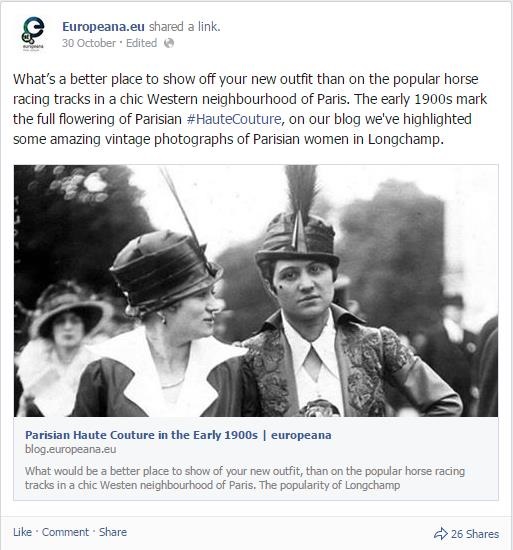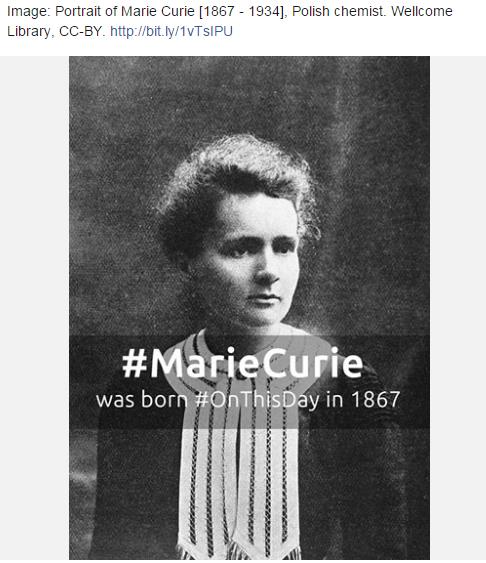Facebook tip #1 for memory institutions - Links, text, images and attribution

A series of blogs by Wiebe de Jager, Marketing Manager at Europeana
#1: Links, texts, images & attribution
Think a moment about the main aim of using Facebook in your cultural heritage institution. You probably want to reach as many people as possible and tell them about your news, or showcase highlights and hidden gems from your collections.
If maximising your reach is indeed your main goal, it’s very important to keep in mind that the length and ‘interestingness’ of your updates greatly influences the reach of each message you post. In other words: short messages with a clear call to action, accompanied by an interesting image will be seen by more people than long, text-only posts.
Be to the point
Facebook uses an advanced newsfeed algorithm that determines what is shown in its users’ timelines. Posts that generate lots of engagement right after posting (ie. people liking or sharing the update) have a higher chance of being shown in someone’s newsfeed. Therefore it’s best to keep the text in your updates as short as possible. Make each post relevant to your audience by studying the results of earlier posts and adapt your messages accordingly. And write like a human being, not like an institution.
Some studies suggest that Facebook posts with just 40 characters (less than this sentence!) receive 86% more engagement than posts with a higher character count. Want to say more? Then write a more extensive post on your blog and link to it. Be to the point and supress the urge to provide too much context in your social media updates.
Another factor that greatly influences the reach of your updates is timeliness. Facebook has been changing its algorithm, boosting posts that are somehow related to trending topics.

Europeana CC BY-SA
This post on the fall of the Berlin Wall for example (with the hashtag #BerlinWall25 both in the text and in the image) got more than 259 likes and reached nearly 13,000 people. Compare that to an update about Rembrandt’s self-portraits, posted just a couple of days later: this update only reached about 2,000 people, and got 49 likes.
Call to action
Try to include not more than one ‘call to action’ in each update: people have to make decisions all day long, so adding more decisions can result in them not taking any action at all. Make the call to action short and clear, and make sure that you put the call to action in the beginning of your message.
Oh, and please don’t put #too #many #hashtags #in #your #Facebook #message; in a sense, they’re calls to actions too, diluting your main call to action. And it doesn’t increase the readability of your message either. One or two hashtags like #Onthisday or thematic hashtags such as #WW1 or #Picasso will do, ‘connecting’ your update to those from other people and institutions.

A typical status update by Europeana – one image, short explanation, one hashtag and a call to action. Europeana CC BY-SA
Say it with pictures
At Europeana, we often say that images are the currency of the web. It is estimated that a post with a picture gets 120% more engagement and 84% more link clicks than a post without. For us, surfacing interesting images from our partners’ collections via social media is one of the most important purposes of our social media activities, as our aim is to highlight the most interesting items in existing and new collections.
We identify images that have the most viral potential using the S.P.E.E.D criteria (more about this in the next blog post) and publish those on Facebook at regular intervals. We only use openly licensed images, ie. images that are in the public domain or have a creative commons licence. We attribute the creator, the image provider and we provide a link to the source of the image. We want the images we share to speak for themselves, so we don’t use low resolution or watermarked images.

Each update contains an image attribution and link to the source. Europeana CC BY-SA
We have evidence that by surfacing just one interesting image, traffic to a specific collection can increase by over 57,000 percent. We will tell you more about that in a forthcoming white paper about our collaboration with Retronaut.
Remember, on social media, your content is the star of the show, not you. Keep that in mind while composing updates. Always try to think from your target audience’s perspective, and make yourself stand out from the noise.
